instrument panel Oldsmobile Cutlass Supreme 1993 Owner's Manuals
[x] Cancel search | Manufacturer: OLDSMOBILE, Model Year: 1993, Model line: Cutlass Supreme, Model: Oldsmobile Cutlass Supreme 1993Pages: 340, PDF Size: 16.21 MB
Page 21 of 340

4. Put someone on. it.
7. or the instrument panel . . .
5. Get it up to speed. Then stop the
"car." The rider doesn't stop.
6. The person keeps going until
stopped by something.
In a real
vehicle, it could be the
windshield
. . .
With safety belts, you slow down as the
vehicle does.
You get more time to stop.
You stop over more distance, and your
strongest bones take the forces. That's
why safety belts make such good sense.
8. or the safety belts!
19
Page 55 of 340
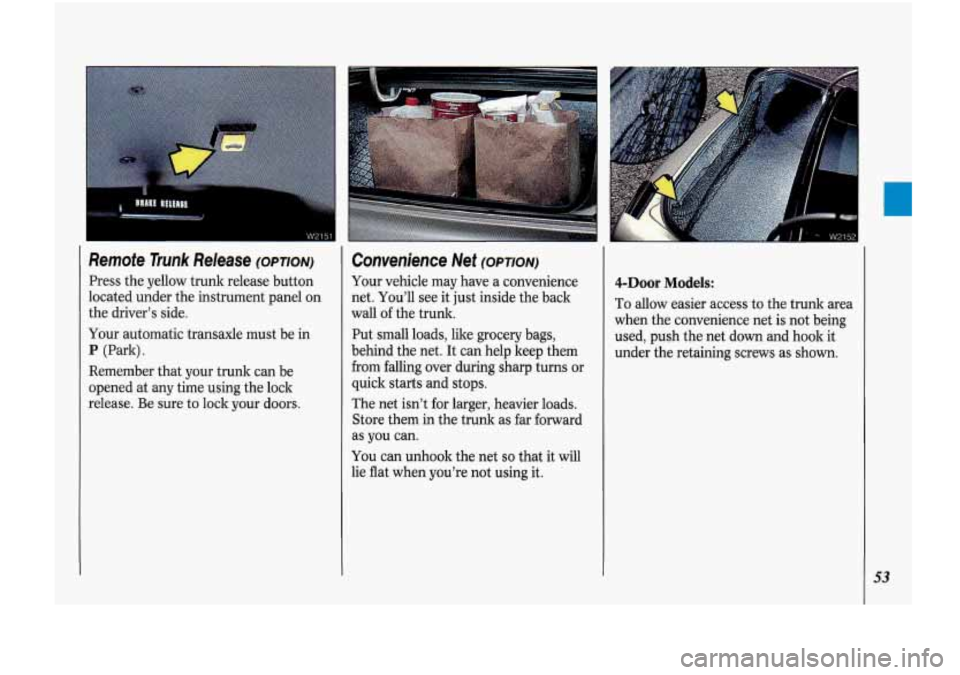
Remote Trunk Release (OPTION)
Press the yellow trunk release button
located under the instrument panel on
the driver’s side.
Your automatic transaxle must be in
P (Park).
Remember that your trunk can be
opened at
any time using the lock
release. Be sure to lock your doors.
Convenience Net (OPTION)
Your vehicle may have a convenience
net. You’ll see it just inside the back
wall
of the trunk.
Put small loads, like grocery bags,
behind the net. It can help keep them
from falling over during sharp turns
or
quick stafts and stops.
The net isn’t for larger, heavier loads.
Store them in the trunk as far forward
as you can.
You can unhook the net so that it will
lie flat when you’re not using it.
4-Door Models:
To allow easier access to the trunk area
when the convenience net is not being
used, push the net down and hook it
under the retaining screws
as shown.
53
Page 72 of 340

70
Features & Controls
Turn Signal and Lane Change
Indicator
(CONT.)
A green arrow on the instrument panel
will flash in the direction of the turn or
lane change.
To signal a lane change, just raise or
lower the lever until the green arrow
starts to flash. Hold it there until you
complete your lane change. The lever
will return by itself when you release it.
As you signal a turn or a lane change, if
the arrows don’t flash but just stay on,
a
signal bulb may be burned out and
other drivers won’t see your turn signal.
If a bulb is burned out, replace it to help
avoid an accident.
If the green arrows
don’t go on at all when
you signal a
turn, check the fuse (see the
Index
under Fuses G Circuit Breakers) and
for burned-out bulbs.
A warning chime will remind you if you
have left your turn signal on for more
than
‘/2 mile (-8 km) of driving.
. Cruise Control (OPTION)
With cruise control, you can maintain a
speed of about
25 mph (40 lun/h) or
more without keeping your foot on the
accelerator. This can really help on long
trips.
Cruise control does not work at speeds
below about
25 mph (40 lun/h).
When you apply your brakes, the cruise
control shuts off.
Page 78 of 340
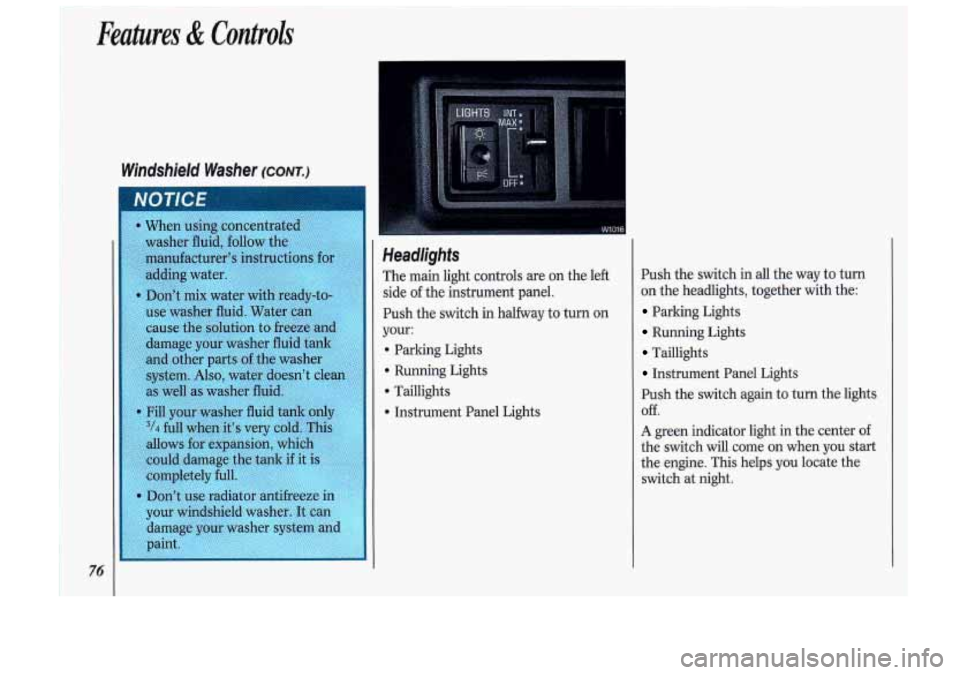
Features & Controls
76
Windshield Washer (CONT.)
Push the switch in all the wa
on the headlights, together u
Parking Lights
Running Lights
Taillights
Instrument Panel Lights
1y to turn
rith the:
Push the switch again to turn the lights
Off.
A green indicator light in the center of
the switch will come on when you start
the engine. This helps you locate the
switch at night.
Page 80 of 340

Features & Controls
78
Daytime Running Lights (CONK)
At dusk, the exterior lights will come on
automatically and the low beams will
change to full brightness. At dawn, the
exterior lights will go out and the low
beams will change to the reduced
brightness of
DRL (if the headlight
switch is off).
Of course, you may still turn on the
headlights any time you need to.
To idle your vehicle with the DRL off,
set the parking brake while the ignition
is in the
Off or Lock position. Then
start the vehicle. The DRL will stay off
until you release the parking brake.
Headlight High-Low Beam
Changer
To change the headlights from low
beam to high or high to low, pull the
turn signal/headlight beam lever all the
way toward you. Then release it.
When the high beams are on,
a blue
light on the instrument panel also will
be on.
Flash-to- Pass
Flash-to-pass lets you use your high
beam headlights
to signal a driver in
front of you that you want to pass.
To use it, pull the turn signal/headlight
beam lever toward you.
If Your Headlights are Off
Your high beam headlights will turn on.
They'll stay on
as long as you hold the
lever there. Release the lever to turn
them off.
If Your Headlights are On:
No flash-to-pass. Use the lever to
change between high and low beams, as
explained under
Headlight High-Low
Beam Changer
earlier in this section.
If You Have Fog Lights:
They go off whenever the high beams
are on. When the high beams go
off, the
fog lights will come on again, if the fog
light switch is on.
Page 81 of 340
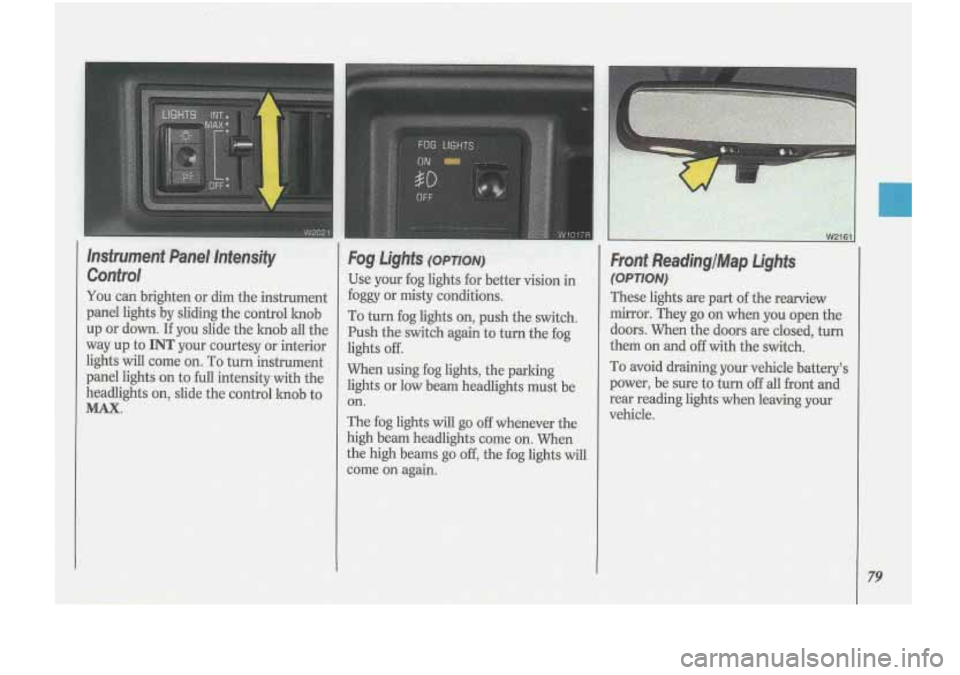
Insfrum~e~t Panel hfensity
Control
You can brighten or dim the instrument
panel lights by sliding the control hob
up or down. If you slide the hob all the
way up to
INT your courtesy or interior
lights
will come on. To turn instrument
panel lights on to
full intensity with the
headlights on, slide the control hob
to
MAX.
Fog (OPTION)
Use your fog lights for better vi'sion in
foggy or misty conditions.
To turn fog lights on, push the switch.
Push the-switch again to turn the fog
lights off.
When using fog lights, the parlung
lights or low beam headlights must be on.
The fog lights will go
off whenever the
high beam headlights come on. When
the high beams go
off, the fog lights will^
come on again.
Front ReadinglMap Ljghfs
(OPTION)
These lights are part of the rearview
mirror. They go on when you open the
doors. When the doors are closed, turn
them on
and off with the switch.
To avoid draining your vehicle battery's
power, be sure
to turn off all front and
rear reading lights-when leaving your
vehicle.
79
Page 91 of 340

The Instrument Panel-
Your Information System
Your instrument panel is designed to let
you know
at a glance how your vehicle
is running. You’ll know how fast you’re
going, how much fuel you’re using, and
many other things you’ll need to drive
safely and economically.
The main components of your
instrument panel are:
1. Turn Signal/Headlight Beam Lever
2. Tilt Steering Wheel Lever
3. Indicator Lights
4. Instrument Cluster
5. Warning Lights
6. Gearshift Lever
7. Audio System
8. Glove Box/Fuse Panel
9. Vents
IO. Vents
11. Climate ControVRear Window
Defogger
12. Ashtray and Lighter
13. Vents
14. Ignition Switch
15. Hazard Warning Flashers Switch
16. Horn
17. Remote Trunk Release (Option)
18. Brake Release
19. Hood Release (on floor by driver’s
20. Light Controls
door)
89
Page 95 of 340

Speedometer (ANALOG CLUSTER)
Your speedometer lets you see your
speed
in both~miles per hour (rnph) and
kilometers per
hour (km/h).
Odometer and Trip Odometer
(ANALOG CLUSTER)
Your odometer shows how far your
vehicle has been driven, in either miles
(used in the U.S.) .or in kilometers
(used
in Canada). Your trip odometer
tells how far you have driven since you
last reset it.
To set it to zero, press the
RESET button located next to the trip
odometer
on the right side of the
instrument panel.
Your Oldsmobile has a tamper resistant
odometer.
If you see silver lines
between the numbers, you’ll know
someone has probably tampered with it
and the numbers may not be true.
You may wonder what happens if your
vehicle needs a new odometer installed.
If the new one can be set to the mileage
total
of the old odometer, then it must
be. But
if it can’t, then-it’s set at zero
and a label must be put
on the driver’s
door to
show the old mileage reading
when the new odometer was installed.
93
Page 112 of 340
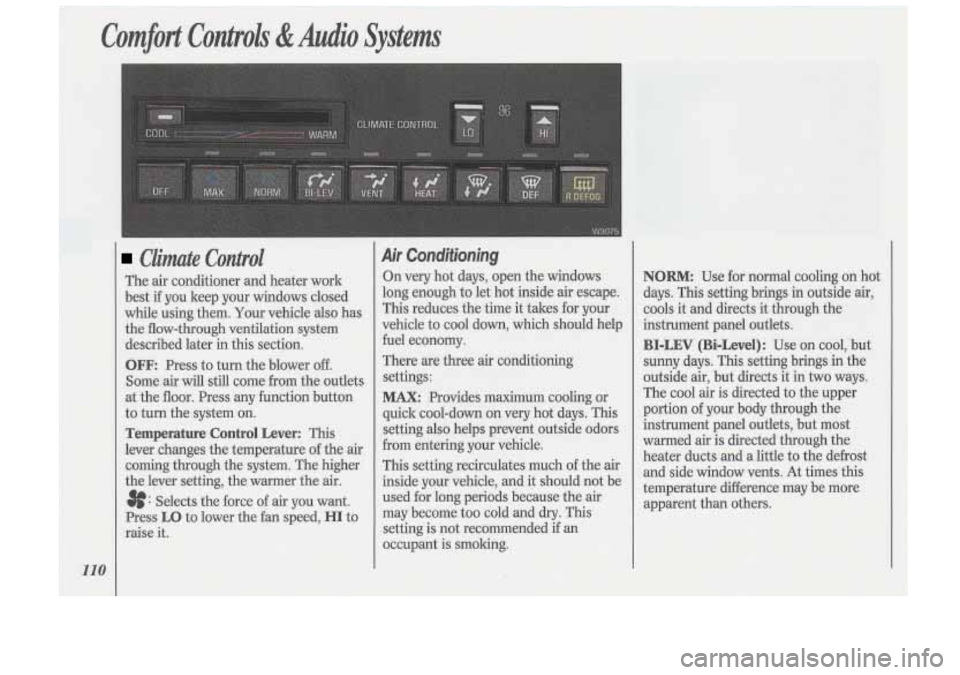
~ Comfort Controls &Audio Systems
i I
I
I
I
! I
I
I
~ 110
Climate Control
The air conditioner and heater work
best
if you keep your windows closed
while using them. Your vehicle also has
the flow-through ventilation system
described later in this section.
OFF: Press to turn the blower off.
Some air will still come from the outlets
at the floor. Press any function button
to turn the system
on.
Temperature Control Lever: This
lever changes the temperature of the air
coming through the system. The higher
the lever setting, the warmer the air.
3f: Selects the force of air you want.
Press
LO to lower the fan speed, HI to
raise
it.
Air Conditioning
On very hot days, open the windows
long enough to let hot inside air escape.
This reduces the time it tales for your
vehicle to cool down, which should help
fuel economy.
There are three air conditioning
settings:
MAX: Provides maximum cooling or
quick cool-down
on very hot days. This
setting also helps prevent outside odors
from entering your vehicle.
This setting recirculates much of the air
inside your vehicle, and it should not be
used for long periods because the air
may become too cold and
dry. This
setting is not recommended if an
occupant is smoking.
NORM: Use for normal cooling on hot
days. This setting brings in outside air,
cools it and directs it through the
instrument panel outlets.
BI-LEV (Bi-Level): Use on cool, but
sunny days. This setting brings in the
outside air, but directs it in two ways.
The cool air is directed to the upper
portion of your body through the
instrument panel outlets, but most
warmed air is directed through the
heater ducts and a little to the defrost
and side window vents. At times this
temperature difference may be more
apparent than others.
Page 113 of 340
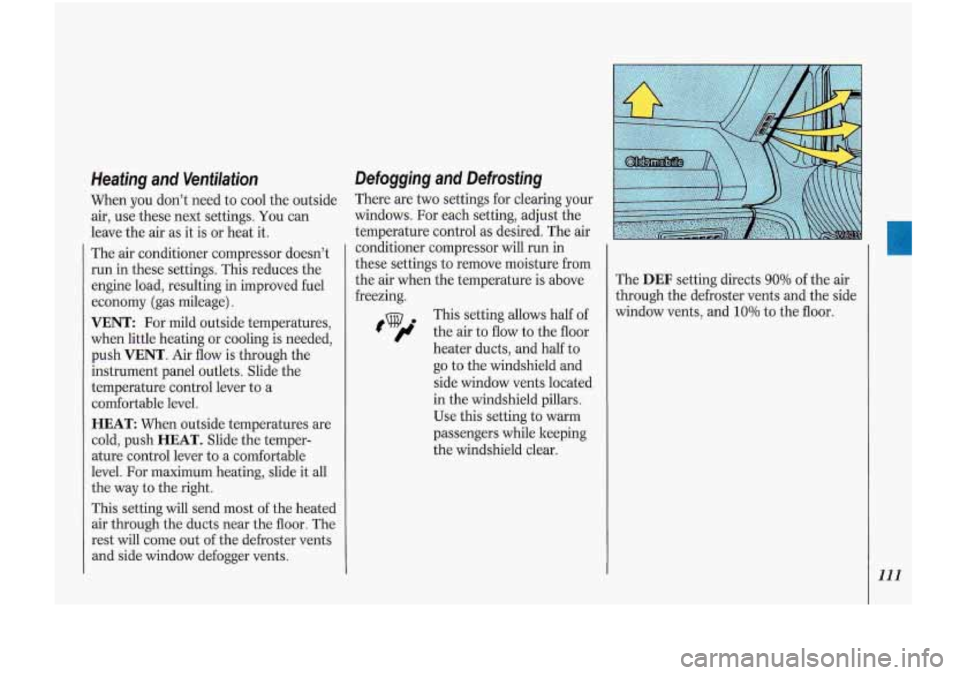
Heating and Venfilafion
When you don’t need to cool the outside
air, use these next settings.
You can
leave the air as it is or heat it.
The air conditioner compressor doesn’t
run in these settings. This reduces the
engine load, resulting in improved fuel
economy (gas mileage)
.
VENT: For mild outside temperatures,
when little heating or cooling is needed,
push
VENT. Air flow is through the
instrument panel outlets. Slide the
temperature control lever to a
comfortable level.
HEAT: When outside temperatures are
cold, push
HEAT. Slide the temper-
ature control lever to a comfortable
level. For maximum heating, slide it all
the way to the right.
This setting will send most of the heated
air through the ducts near the floor. The
rest will come out of the defroster vents
and side window defogger vents.
Defogging and Defrosting
There are two settings for clearing your
windows. For each setting, adjust the
temperature control
as desired. The air
conditioner compressor will run in
these settings to remove moisture from
the air when the temperature
is above
freezing.
tv th This setting allows half of
e air to flow to the floor
heater ducts, and half to
go to the windshield and
side window vents located
in the windshield pillars.
Use this setting to warm
passengers while keeping
the windshield clear. The
DEF setting directs 90% of
the air
through the defroster vents and the side
window vents, and
10% to the floor.
111